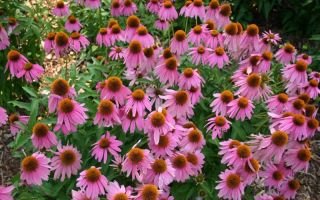Content
- 1 What does Echinacea medicinal look like and where does it grow?
- 2 Echinacea chemical composition
- 3 What is echinacea useful for the body and what helps
- 3.1 Benefits of echinacea leaves
- 3.2 Echinacea root benefits
- 3.3 Why inflorescences are useful
- 3.4 The benefits of echinacea for a woman's body
- 3.5 What diseases and what helps echinacea for men
- 3.6 Will echinacea help with HPV type 31
- 3.7 Does Echinacea Help Boost Immunity?
- 3.8 Why is echinacea syrup useful?
- 3.9 Indications for the use of echinacea in homeopathy
- 4 How to use and how to use echinacea medicinally
- 5 The use of echinacea in traditional medicine
- 6 Application in dietetics
- 7 Cooking applications
- 8 Application in cosmetology
- 9 Contraindications to the use of echinacea and side effects
- 10 Interaction with other medications
- 11 Collection and procurement of raw echinacea
- 12 Echinacea's magical properties
- 13 Conclusion
- 14 Reviews of the medicinal properties of echinacea and contraindications
The benefits and harms of echinacea for the body are very diverse. The plant is found in many folk recipes and deserves careful study.
What does Echinacea medicinal look like and where does it grow?
Healing purple Echinacea (Echinacea purpurea) is a perennial plant from the Astrov family up to 1 m tall. The shoots of the grass are straight and rough to the touch, the leaves at the surface of the ground are broadly oval and on long petioles, and on the stem are lanceolate sessile. In the photo and in the description of the medicinal echinacea flower, you can see that the plant brings large baskets, consisting of purple-pink and reddish-brown buds.
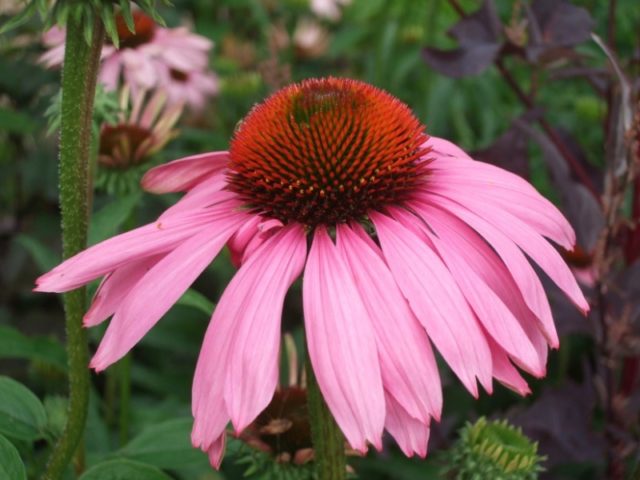
The homeland of Echinacea is considered the eastern part of North America. In a decorative form, the plant is cultivated all over the world.
Where does Echinacea grow in Russia
The heat-loving echinacea is most often found in the North Caucasus and in the southwestern regions of Russia. The plant usually chooses sunny areas and fertile soils with moderate moisture.
Echinacea chemical composition
The ground parts of echinacea and its roots are rich in nutrients. Among the main ones are:
- resins and organic acids;
- glycosides and alkaloids;
- tannins;
- aluminum, potassium and nickel;
- phenol carboxylic acids;
- manganese, zinc, chlorine and silver;
- phytosterols;
- beryllium, barium and vanadium;
- polysaccharides;
- iron and selenium;
- ascorbic acid;
- essential oils;
- betaine;
- inulin.
Plant-based products are widely used to treat diseases and strengthen weakened immunity.
What is echinacea useful for the body and what helps
When used carefully according to prescriptions, the medicinal properties of purple echinacea are:
- improve the body's resistance to viruses and infections;
- promote skin regeneration and damage healing;
- improve the condition of the epidermis and have a rejuvenating effect;
- strengthen blood vessels and reduce the level of bad cholesterol;
- cleanse the blood and lymphatic system;
- improve kidney and liver function;
- hinder the development of oncological processes;
- accelerate metabolism and digestion;
- help with overwork, insomnia and depression;
- reduce fever for colds;
- fight inflammation in the body;
- help with bacterial processes - Escherichia coli, staphylococcus, streptococcus.
The medicinal plant materials of purple echinacea are able to reduce the manifestations of allergies.
Benefits of echinacea leaves
Echinacea herb treats anemia - the leaves are high in iron. The plant contains selenium, which prevents the development of oncological tumors, and antioxidants, which prevent the aging of the body.
Echinacea root benefits
Inulin is present in the roots of the plant, which takes part in metabolic processes and stimulates the breakdown of fats. Echinacea is useful for cleansing the intestines and liver, in order to lose weight.
Why inflorescences are useful
Echinacea buds contain an increased amount of essential oils. Funds based on inflorescences help well with inflammation, stimulate immunity and have a beneficial effect on the central nervous system.
The benefits of echinacea for a woman's body
Echinacea leaves and flowers contain phytosterols, which normalize hormonal balance and the monthly cycle. Women can use herbal remedies for painful periods and menopause to relieve discomfort.
It is undesirable to use echinacea during pregnancy, it tones the uterine muscles and can provoke a miscarriage. When breastfeeding, the plant is used only two months after childbirth and as directed by a doctor.
What diseases and what helps echinacea for men
The medicinal properties of the perennial flower echinacea strengthen blood vessels and the heart system in men. The plant reduces the likelihood of developing strokes and heart attacks, helps to maintain strength, endurance and a healthy libido for longer.
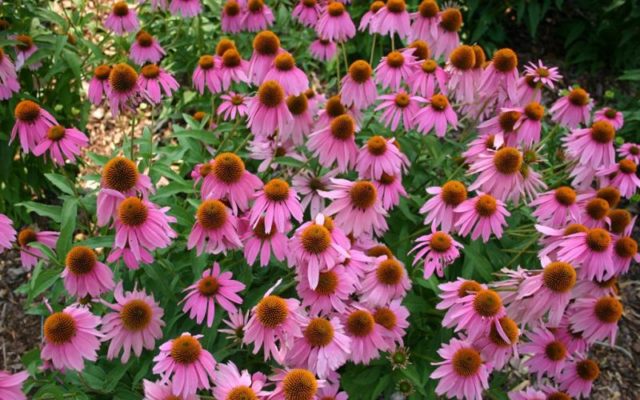
Will echinacea help with HPV type 31
The medicinal effect of the plant in the papilloma virus has not been proven. But at the same time, the beneficial properties of echinacea are used to prevent relapse of the disease. The herb improves immunity and improves metabolic processes in the body, which reduces the risk of papillomas recurrence.
Does Echinacea Help Boost Immunity?
Echinacea medications increase the immune system. It is useful to take funds in the autumn-winter period for preventive purposes. Drinking decoctions of the plant is recommended at the first symptoms of respiratory infections, in which case it is possible to cope with ARVI in just a couple of days.
Why is echinacea syrup useful?
Echinacea sweet syrup is used to treat inflammation and allergies, as well as to strengthen the immune system. The preparation contains glucose, which improves its taste. The syrup from the plant is good for coughs and sore throats, as it softens the sore throat and relieves pain.
Indications for the use of echinacea in homeopathy
The medicinal properties of echinacea and the herbal benefits of the herb are actively used in homeopathy. Infusions, extracts and syrups are recommended for use:
- for colds and for its prevention;
- to cleanse the liver and kidneys;
- to normalize bowel function;
- to calm the nervous system;
- for the treatment of bronchitis and pneumonia;
- with cystitis;
- with abscesses and boils;
- in case of poisoning;
- with allergic infections.
How to use and how to use echinacea medicinally
Traditional medicine indicates numerous ways of using echinacea with doses and rules of use. You can make healthy herbal remedies at home.
Echinacea infusion
A simple water infusion of the plant promotes wound healing, helps with psoriasis and eczema, accelerates regeneration in case of burns. Prepare the tool like this:
- chop a large spoonful of dry echinacea stems and leaves;
- pour 500 ml of boiling water in a thermos;
- kept under the lid all night, and filtered in the morning.
Instructions for the use of echinacea solution recommends using a lotion and rub. Inside, the infusion is consumed in 80 ml three times a day.
Echinacea decoction
In the form of a decoction, echinacea is used to tone up and strengthen the immune system. The recipe looks like this:
- dry leaves and flowers of the plant are crushed in the volume of a small spoon;
- raw materials are poured with 250 ml of hot liquid;
- in a water bath, heat for 20 minutes over low heat;
- insist the product under the lid for another half hour.
Strained echinacea broth should be consumed 1/3 cup three times a day on an empty stomach.
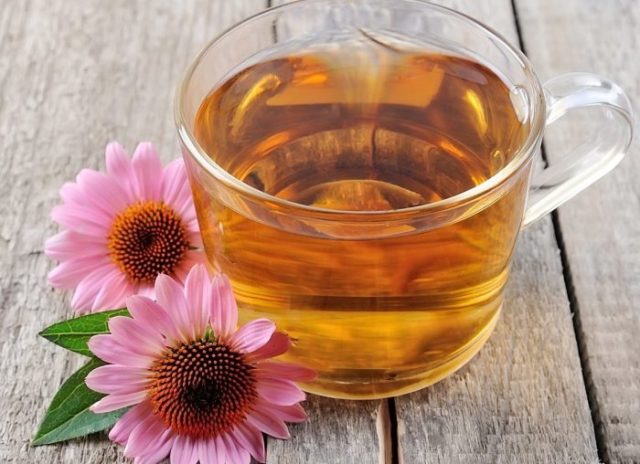
Echinacea extract, powder
Echinacea flower can be used for treatment in the form of a dry extract, or a powder from dried leaves and buds. The concentrated agent has antiviral and anti-inflammatory effects. Echinacea powder should be consumed in small dosages - no more than 2 g once a day. It is not required to drink the product with water.
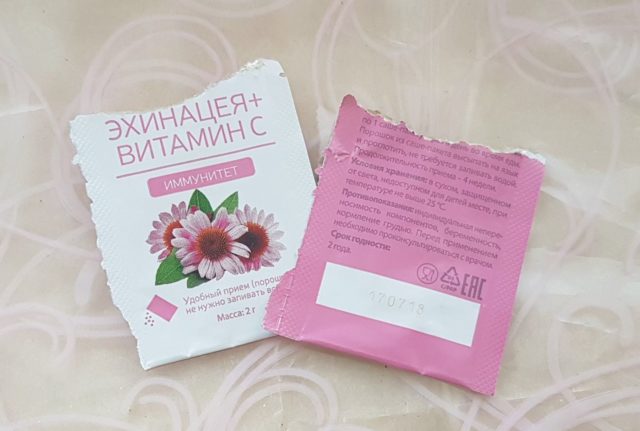
Echinacea syrup
The plant-based sweet syrup can be bought at the pharmacy or made by yourself. In the latter case, the leaves and flowers are treated in a water bath for about 20 minutes, as when preparing a decoction, but an equal amount of sugar is added to the solution.
Instructions for the use of echinacea syrup for adults advises to use it for allergies, inflammations and diseases of the respiratory system.

Echinacea juice
A concentrated juice can be obtained from fresh leaves and stems of the plant. Raw materials are crushed in a blender or manually ground with a mortar, and then squeeze the mass through cheesecloth.
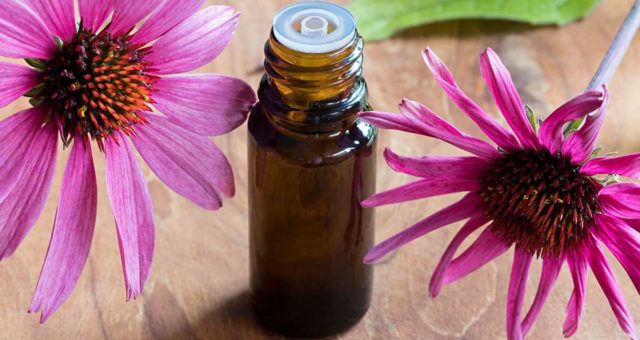
It is not customary to use plant juice inside. It is mainly used to treat skin lesions, as it speeds up the healing process.
Oil
An oil based on echinacea flowers brings benefits when applied externally. They do it like this:
- 30 g of fresh buds are poured into a glass jar;
- poured with unrefined sunflower oil in a 1: 5 ratio;
- incubated in a dark place for three weeks and filtered.
The prepared oil is used to wipe skin lesions and irritations. It can be used for cosmetic purposes to soften the epidermis.
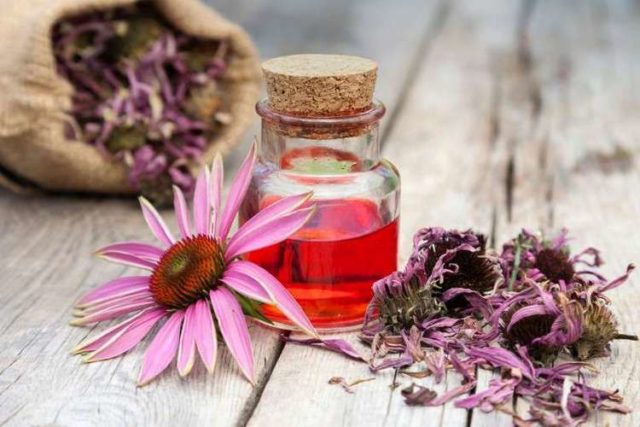
The use of echinacea in traditional medicine
There are many recipes for home medicinal use of echinacea. Several of them are particularly popular.
With liver diseases
Such a remedy brings a good effect for liver ailments:
- 50 g of fresh or dry echinacea pour 250 ml of unrefined olive oil;
- insist three weeks in a shaded place under the lid;
- passed through cheesecloth for filtration.
Take oil only 10 ml three times a day. You need to use the product in between meals.
With cystitis
A water infusion of Echinacea helps to get rid of inflammation of the urinary tract. The recipe looks like this:
- 100 g of dried flowers and leaves are poured into 1 liter of hot water;
- leave under the lid for 8-10 hours;
- passed through cheesecloth for filtration.
Instructions for the use of echinacea medicine recommends taking an infusion of 100 ml up to five times a day.The course of treatment takes five days, if it was not possible to cope with the inflammation during this time, after a week's break, the therapy is repeated.
With a cold
With acute respiratory viral infections and influenza, echinacea infusion is taken orally. To prepare it you need:
- pour 50 g of dried buds and leaves with a glass of boiling water;
- keep under the lid for eight hours;
- strain through a sieve and folded gauze.
The infusion is taken half a glass three times a day on an empty stomach. In total, the treatment takes ten days.
High temperature
The medicinal plant helps fight inflammation and lowers fever for colds. For medicinal purposes, such a decoction is prepared:
- 30 g of dried flowers are poured into a glass container;
- pour 500 ml of boiling water;
- boil over low heat for ten minutes under the lid;
- kept closed for five hours.
The filtered echinacea broth is drunk 125 ml three times a day until the condition normalizes. If desired, you can add a spoonful of raspberry jam to the medicine.
With angina
A decoction of the medicinal echinacea helps with angina and eliminates bacterial processes. The recipe is as follows:
- a large spoonful of dry raw materials is poured with 500 ml of boiling water;
- Warm up over low heat for half an hour in a water bath;
- stand under the lid until cool and filtered.
Echinacea decoction should be consumed 80 ml three times a day.
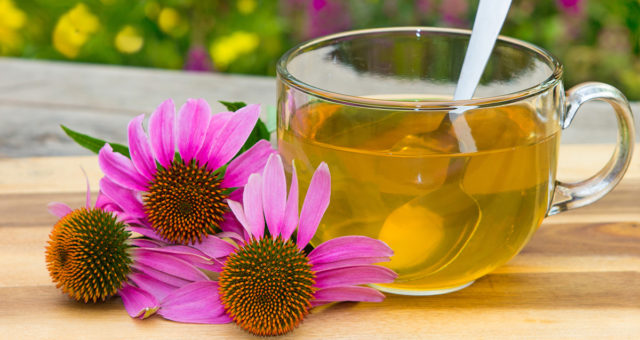
With hypertension
Echinacea purpurea helps regulate blood pressure. In the treatment of hypertension, the following remedy is used:
- 100 g of dried flowers of the plant are crushed to a powder state;
- mixed with 300 g of natural honey;
- bring to homogeneity.
You need to take the mixture 5 ml once a day. If desired, you can dilute the product in herbal tea.
With candidiasis
Echinacea has antifungal properties and helps with thrush in women. Prepare the following aqueous infusion:
- 50 g of raw materials are poured with two glasses of boiling water;
- kept closed for five hours;
- filter through cheesecloth.
Soak a tampon with a slightly warm agent and insert it inside the body for the whole night.
Instructions for using the herb Echinacea for immunity
The plant can be used not only to treat colds, but also to prevent them. As a preventive measure, it is useful to drink tea on grass leaves:
- 10 g of plant raw materials are brewed with 200 ml of boiling water;
- kept under the lid for only three minutes;
- filter through a fine sieve.
You need to drink tea twice a day; it is useful to add a little natural honey to the solution. In total, the course of preventive admission takes ten days.
External use of echinacea
Medicinal echinacea is used at home by external methods to treat irritations and skin inflammations. In particular, it is used by:
- in healing baths - five large tablespoons of dry echinacea leaves are poured into 1 liter of boiling water and infused for an hour, and then the strained agent is added to the filled container;
- for rubbing and lotions - two large tablespoons of herbs are poured with 500 ml of boiling water, kept under a lid for two hours and treated with warm medicine sore areas.
Echinacea speeds up the healing of damage and inhibits the development of bacterial processes.
Application in dietetics
Inulin, caffeic acid and other components of the plant help to improve carbohydrate metabolism. Due to this, echinacea can be used on a diet, it will ensure the proper breakdown of fats, and also remove toxins from the body.
Cooking applications
Echinacea is most often used to brew aromatic and healthy teas. In addition, the plant's fresh green leaves can be added to salads, stews, and soups in the last stages of cooking.

Application in cosmetology
Echinacea soothes irritated skin, helps to normalize oiliness and helps get rid of acne. With problematic epidermis, the following mask is beneficial:
- 5 ml of echinacea infusion is mixed with an equal amount of flower honey;
- add a large spoonful of rye flour;
- mix the mass and apply on the face for ten minutes.
It is recommended to use the product twice a week. The potential harm from echinacea extracts in cosmetics is that the herb, if overdosed, can cause breakouts and redness.
Echinacea for hair
Infusions and decoctions from the root and leaves of Echinacea are used to rinse the hair. They can be used in pure form or in combination with pharmacy chamomile, string, or fresh lemon juice to increase smoothness and volume.
The healing properties of echinacea help with dandruff. In this case, the flowers and leaves are crushed to a state of gruel and mixed with chicken yolk, after which they are applied to the root region of the head for half an hour.
Contraindications to the use of echinacea and side effects
The medicinal properties and contraindications of the echinacea plant are closely related to each other. Do not use herbal products:
- with tuberculosis and sarcoidosis;
- with leukemia;
- during pregnancy;
- with multiple sclerosis;
- with individual allergies;
- with severe hypertension;
- with exacerbation of pancreatitis and peptic ulcer.
Oncology is not a contraindication for echinacea, if we are not talking about blood cancer. However, the plant can only be consumed with the permission of a doctor and after chemotherapy. For tumors in the developmental stage, it is better to refuse the medicinal herb.
Interaction with other medications
The health benefits and harms of echinacea depend on combining the plant with other pharmaceutical and natural remedies. The herb can cause side effects when consumed:
- with preparations containing caffeine;
- with estrogen and cyclosporine;
- with lovastatin and clarithromycin;
- with indinavir and triazolam.
Echinacea should not be combined with liver-converted medications. The plant is not taken simultaneously with immunosuppressants, since the effectiveness of the latter decreases.
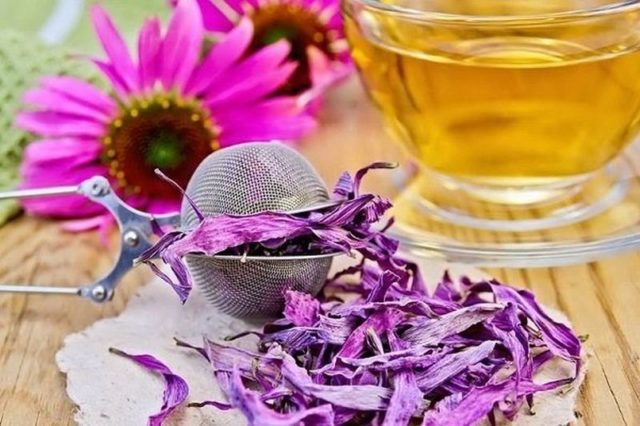
Collection and procurement of raw echinacea
In order for the plant to fully reveal its useful qualities, it is necessary to properly harvest and dry the echinacea. It is necessary to collect grass exclusively in areas with a clean ecology and without factories and roads located near.
What to Collect with Echinacea for Treatment
Both ground and underground parts of the grass have useful properties. For medicinal purposes, you can collect the roots of the plant, its leaves, stems and inflorescences.
When to collect echinacea for medicine, for drying for the winter
The optimal time for harvesting echinacea is the period of active flowering from mid-July. The roots are dug up in the fall at the end of the growing season, not earlier than October.
How to collect and dry Echinacea officinalis
To harvest leaves and flowers, the plant is cut at a height of about 35 cm from the ground. This is best done early in the morning. Echinacea roots are carefully dug out of the soil on a dry but cool day.
The collected raw materials are thoroughly washed from soil residues and dust, sorted out and laid out for drying outside in the shade or in a warm room. Roots and large leaves can be pre-cut with a knife. It is allowed to use an electric dryer heated to approximately 50 ° C for echinacea.

Store raw materials in paper bags or fabric bags in a dark place with a low level of humidity. The valuable properties of the workpiece are retained for about two years.
Echinacea's magical properties
Folk omens endow the plant with magical properties.It is believed that echinacea awakens latent mental strength to combat difficulties and depression, raises morale and helps get rid of unnecessary anxiety. The dried petals of the plant can be carried in a small bag as an amulet.
Conclusion
The benefits and harms of echinacea for the body are closely interrelated. It is necessary to take the plant carefully and in small courses, given the compatibility with other drugs and side effects. When used correctly, the herb helps to strengthen the immune system and improve overall tone.

